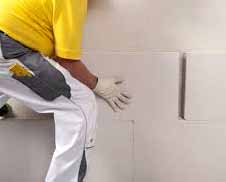
mineral foam plates beeing fixed
The building materials industry classifies interior-insulation-systems increasingly as lucrative market. Here, the swing goes from impermeable material, to open to diffusion and capillary systems. The specially developed plates have the following basic pattern: lime, cement, sand and egg white proteins for frothing. The bulk density is low with values less than 100 kg/m3. This brings good insulation values. With the plates U-values from 0.5 to 0.4 W (m2K) can be achieved. When wall mounting the manufacturer’s instructions should be followed.
Weaknesses of the vapor-proof systems are avoided
Structures against the wall with mineral wool and a vapor barrier or diffusion-tight synthetic foams prevent vapor diffusion current into the wall. But at the same time blocking the drying of the walls inward, as in the summer would be possible. Vapor barriers can be damaged by use or are even already faulty when attaching, for example if Outlets are located in the exterior wall area. Density systems also contribute to indoor climate at nothing because they can not buffer humidity. Diffusion Open systems do not require a vapor barrier. They can absorb moisture peaks in the air and allow the drying out of the walls inside.
Processing instructions
Experienced providers such as Redstone or Multipor provide detailed product and processing information for system-specific working. The vapor-permeable adhesive or light mortar is applied with a spatula no. 10 full surface of the plate. For sound insulation, a tape or a hemp-felt sound insulation is laid under the first layer. The first row of stones is particularly lot and flush execute. Heating pipes can be omit, since the stone is easy to work with a saw. Shock and horizontal joints are not glued. The external wall insulation is to be continued up to 50 cm inside. Not to be forgotten are the window frames. For this manufacturers offer special thinner plates. Ceiling insulation panels are to be fixed additionally with 4 plate anchors per square meter.
After the entire surface of the mounting plates a fabric is smoothed out. The layer density is about 5 millimeters. The surfaces can be plastered with either lime or clay, or painted with silicate interior wall paint.
Clarify potential problems in the execution in advance
As long as there no electrical outlets are located in the wall and there are no radiator in front of it, the processing for the expert is relatively simple. Otherwise, the sockets must be removed and installed with extension pieces again. Radiators are to move if necessary. They must not be anchored in the new insulation system, but in the underlying solid wall construction. The special cases mentioned above are to be agreed in advance with electricians or heating engineers.
Required insulation thickness
The mineral insulation boards are available in different strengths, such as five, eight or ten inches. Since every inch of material thickness costs money, the optimal wall construction should be calculated. The manufacturer Redstone and Multipor offer physical calculations. The most common calculation programs are “WUFI per” the IBP wooden churches (www.wufi.de) and “Dolphin” at the TU Dresden (www.bauklimatik-dresden.de/delphin). For use come the “Technical Guidelines of the internal insulation of external walls with Interior wall insulation”. Many practical tips with constructive examples provides the building book 2013/2014, which can be accessed under “Baubuch” www.multipor.de/.
